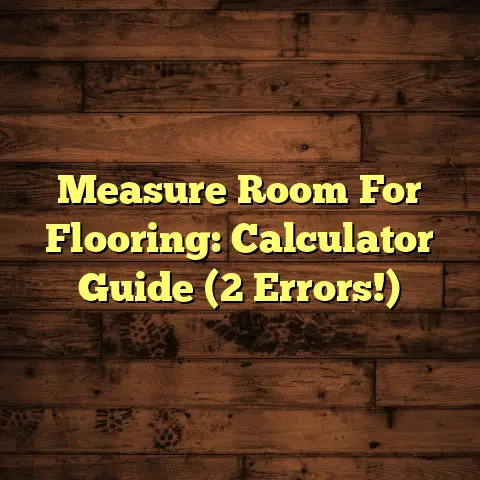Hide Speaker Wires on Floors? (4 Pro Secrets!)
I’m your friendly neighborhood flooring contractor, and I’m here to talk about something that’s near and dear to my heart:
Making your home look amazing while still enjoying that sweet, sweet sound.
Let’s face it: Speaker wires snaking across your floor are an eyesore.
They’re a tripping hazard, a dust magnet, and they just plain ruin the aesthetic of a well-designed room.
But fear not!
Hiding those pesky wires is totally achievable, and it doesn’t require a complete home renovation.
Now, before we dive into the nitty-gritty, let’s talk about something crucial:
Your climate.
Yep, you heard me right.
Whether you’re battling humidity in Florida or braving the cold in Minnesota, your environment plays a huge role in choosing the right flooring materials and wire-hiding methods.
- Humid climates might require moisture-resistant flooring and adhesives.
- Colder regions may need extra insulation and durable materials that can withstand temperature fluctuations.
Think of it this way:
Hiding speaker wires isn’t just about aesthetics; it’s about protecting them from the elements and ensuring they last.
In this article, I’m going to pull back the curtain and share four pro secrets that I’ve learned over years of flooring and home theater installations.
These secrets will help you achieve a clean, organized look without sacrificing sound quality or breaking the bank.
Ready to ditch those unsightly wires and create the home theater of your dreams?
Let’s get started!
Section 1: Pro Secret #1 – Choosing the Right Flooring Material
Okay, let’s talk flooring.
It’s the foundation of any room, and it plays a major role in how easy (or difficult) it is to hide speaker wires.
Here’s a rundown of some common flooring materials and their pros and cons when it comes to wire concealment:
- Hardwood: Classic, beautiful, and relatively easy to work with. You can often run wires under baseboards or even carefully route them within the subfloor (more on that later).
- Laminate: A more affordable alternative to hardwood. It’s durable and comes in a wide variety of styles. Similar to hardwood, you can often hide wires along the edges of the room.
- Tile: Great for high-moisture areas like bathrooms and kitchens. However, it can be tricky to hide wires with tile, as you’ll need to consider grout lines and potential drilling.
- Carpet: The softest option and naturally muffles sound, which is great for home theaters. Hiding wires under carpet is relatively easy, but you need to be careful to avoid creating bumps or tripping hazards.
Climate Considerations:
- High-moisture areas: I’d recommend laminate or tile. Look for waterproof or water-resistant options to prevent warping or damage.
- Colder climates: Hardwood or carpet can provide extra insulation. Consider adding a subfloor with insulation to further improve energy efficiency.
Sound Quality:
Did you know that your flooring can actually impact the acoustics of your room?
Hard surfaces like hardwood and tile can reflect sound, creating echoes and reverberation.
Carpet, on the other hand, absorbs sound, which can help to create a more balanced and enjoyable listening experience.
If you’re serious about sound quality, consider adding area rugs to hardwood or tile floors to dampen reflections.
Preparing the Surface:
Before you even think about hiding wires, it’s crucial to prepare your flooring surface properly.
This means:
- Cleaning: Remove all dirt, dust, and debris.
- Leveling: Address any uneven spots or bumps.
- Repairing: Fix any cracks or damage.
A smooth, clean surface will make it much easier to install cable management solutions and ensure that your wires are properly concealed.
Personal Experience:
I once worked on a home theater project where the client insisted on installing hardwood floors, despite living in a very humid climate.
I strongly advised against it, but they were adamant.
Sure enough, within a year, the floors started to warp and buckle.
We ended up having to replace the entire floor with a moisture- resistant laminate.
Lesson learned: Always consider your climate when choosing flooring materials!
Bottom Line:
Choosing the right flooring material is the first step to successfully hiding speaker wires.
Consider your climate, your budget, and your aesthetic preferences when making your decision.
And don’t forget to prepare the surface properly before you start installing anything!
Section 2: Pro Secret #2 – Utilizing Cable Management Solutions
Alright, now that we’ve got our flooring sorted out, let’s talk about the real magic:
Cable management solutions!
These are the tools and techniques that will help you to actually hide those wires and create a clean, organized look.
Here are a few of my go-to options:
- Cable Raceways: These are basically plastic channels that attach to your wall or floor and hold your wires. They come in a variety of sizes and colors, and they’re a great way to conceal multiple wires at once.
- Cord Covers: Similar to cable raceways, but they’re typically smaller and more flexible. They’re ideal for running wires along baseboards or under furniture.
- Wire Duct Systems: These are more elaborate systems that can be installed within walls or floors. They’re a great option for new construction or major renovations.
Selecting the Right Solution:
The best cable management solution for you will depend on your flooring type, your room layout, and your personal preferences.
- For hardwood or laminate: Cable raceways and cord covers are usually the easiest options. You can attach them to the baseboards or run them along the edges of the room.
- For tile: You may need to get creative. Consider running wires under area rugs or using a wire duct system that’s installed within the subfloor.
- For carpet: You can often hide wires under the carpet itself, but you’ll need to be careful to avoid creating bumps or tripping hazards. Consider using flat wire or running wires along the tack strip.
Innovative Products:
The market is full of innovative cable management solutions that blend seamlessly with different flooring styles.
I’ve seen some amazing products that look like wood trim, metal accents, or even part of the baseboard.
Do some research and find a solution that matches your decor and your budget.
Step-by-Step Installation:
Okay, let’s get practical.
Here’s a general guide to installing cable management solutions:
- Plan your route: Determine the best path for your wires. Consider accessibility and future adjustments.
- Measure and cut: Measure the length of the raceway or cord cover and cut it to size.
- Attach the solution: Use adhesive, screws, or clips to attach the cable management solution to your floor or wall.
- Insert the wires: Carefully insert the speaker wires into the raceway or cord cover.
- Conceal the solution: If desired, paint or stain the cable management solution to match your decor.
Climate-Specific Installation Tips:
- High-humidity areas: Use adhesives that are specifically designed for high-moisture environments.
- Colder climates: Use fasteners that can withstand temperature fluctuations.
Accessibility:
Remember to keep accessibility in mind when installing cable management solutions.
You may need to access the wires in the future for adjustments or repairs.
Choose a solution that allows you to easily remove or replace the wires without damaging your flooring.
Personal Experience:
I once installed a wire duct system in a client’s basement home theater.
The basement was prone to flooding, so I made sure to use waterproof materials and seal all the connections.
A few months later, the basement flooded, but the wire duct system protected the speaker wires from damage.
The client was thrilled!
Bottom Line:
Cable management solutions are essential for hiding speaker wires and creating a clean, organized look.
Choose the right solution for your flooring type, your room layout, and your climate.
And don’t forget to plan ahead and keep accessibility in mind!
Section 3: Pro Secret #3 – Creative Décor Techniques
Now, let’s get creative!
Hiding speaker wires doesn’t have to be a purely functional exercise.
You can actually incorporate them into your room’s design and make them a part of your decor.
Here are a few ideas:
- Area Rugs: A well-placed area rug can completely hide speaker wires that are running across the floor. Choose a rug that complements your decor and provides adequate coverage.
- Furniture Placement: Strategically place furniture to conceal wires. For example, you can run wires behind a sofa, bookshelf, or entertainment center.
- Decorative Elements: Use decorative elements to disguise wires. For example, you can wrap wires in fabric, beads, or artificial vines.
Climate Considerations:
- Warmer climates: Lighter fabrics and materials can help to keep your room cool and comfortable.
- Colder climates: Heavier materials can provide extra insulation and warmth.
DIY Solutions:
There are tons of DIY solutions that allow you to express your personal style while maintaining a clean look for your speaker wires.
Here are a few ideas:
- Paintable Cord Covers: Paint cord covers to match your wall color.
- Fabric-Wrapped Wires: Wrap wires in fabric that matches your decor.
- Beaded Wires: String beads onto wires to create a decorative accent.
Functionality vs. Design:
It’s important to balance functionality with design when hiding speaker wires.
You want your wires to be concealed, but you also want to ensure that they’re not interfering with sound quality.
Avoid kinking or bending wires too sharply, as this can degrade the signal.
Also, make sure that your wires are properly insulated to prevent interference.
Personal Experience:
I once worked on a project where the client wanted to hide speaker wires in a very visible location.
We ended up using a decorative cord cover that looked like a piece of artwork.
The cord cover not only concealed the wires, but it also added a unique and stylish touch to the room.
Bottom Line:
Hiding speaker wires can be a fun and creative process.
Use area rugs, furniture placement, and decorative elements to disguise wires and enhance your room’s aesthetics.
And don’t be afraid to get creative with DIY solutions!
Section 4: Pro Secret #4 – Professional Installation Options
Okay, let’s talk about when it might be appropriate to call in the pros.
While many of the techniques I’ve discussed are DIY-friendly, there are times when professional installation is the best option.
Here are a few scenarios:
- Complex Wiring: If you have a complex wiring setup or you’re not comfortable working with electrical components, it’s best to hire a professional.
- In-Wall Wiring: Running wires inside walls requires specialized tools and knowledge. It’s also important to comply with local building codes.
- Challenging Climates: In extreme climates, professional installers can use specialized materials and techniques to ensure that your wires are properly protected.
Evaluating Professional Services:
If you decide to hire a professional installer, it’s important to do your research and choose someone who is qualified and reliable.
Here are a few questions to ask:
- Are you licensed and insured?
- Do you have experience with similar projects?
- Can you provide references?
- What is your pricing structure?
Advantages of Professional Installation:
- Expertise: Professional installers have the knowledge and experience to handle complex wiring projects.
- Safety: Professional installers are trained to work safely with electrical components.
- Quality: Professional installers use high-quality materials and techniques to ensure a long-lasting installation.
- Warranty: Many professional installers offer a warranty on their work.
Case Studies/Testimonials:
I’ve seen countless homeowners who have successfully hidden their speaker wires through professional services.
They often report that the peace of mind and the quality of the installation are well worth the cost.
Potential Costs:
The cost of professional installation will vary depending on the complexity of the project and the location of your home.
Get quotes from multiple installers before making a decision.
Budgeting for Professional Installation:
When budgeting for professional installation, be sure to factor in the cost of materials, labor, and any permits that may be required.
It’s also a good idea to set aside a contingency fund for unexpected expenses.
Personal Experience:
I once worked on a project where the client attempted to install in-wall wiring themselves.
They ended up damaging the walls and creating a fire hazard.
We had to come in and repair the damage, which cost them more in the long run than if they had hired us in the first place.
Bottom Line:
Professional installation is a great option for complex wiring projects or when you’re not comfortable doing it yourself.
Do your research, get quotes from multiple installers, and budget accordingly.
Conclusion
Alright, we’ve covered a lot of ground!
Let’s recap the key points:
- Aesthetics and Functionality: Hiding speaker wires is about both making your home look good and ensuring that your audio system performs well.
- Climate Considerations: Your climate plays a crucial role in choosing the right materials and methods for wire concealment.
- Four Pro Secrets:
- Choose the right flooring material.
- Utilize cable management solutions.
- Get creative with decor techniques.
- Consider professional installation.
I hope these four pro secrets have given you the confidence and knowledge to tackle your own speaker wire hiding project.
Remember, with the right approach, hiding speaker wires can be an achievable and rewarding project.
It can transform your living space and enhance your audio experience.
So, what are you waiting for?
Grab your tools, gather your materials, and get started!
And if you ever need a little extra help, you know where to find me.
Happy listening!





